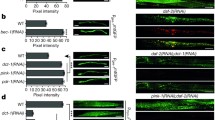Abstract
Eukaryotic cells heavily depend on ATP generated by oxidative phosphorylation (OXPHOS) within mitochondria. Besides being the main suppliers of cell’s energy, mitochondria also provide an additional compartment for a wide range of cellular processes and metabolic pathways. Mitochondria constantly undergo fusion/fission events and form a mitochondrial network, which is a highly dynamic, tubular structure allowing for rapid and continuous exchange of genetic material, as well as, targeting dysfunctional mitochondria for degradation through mitochondrial selective autophagy (mitophagy). Mitophagy mediates the elimination of damaged and/or superfluous organelles, maintaining mitochondrial and cellular homeostasis. In this chapter, we present two versatile, noninvasive methods, developed for monitoring in vivo mitophagy in C. elegans. These procedures enable the assessment of mitophagy in several cell types during development or under stress conditions. Investigating the role of mitophagy at the organismal level is essential for the development of therapeutic interventions against age-related diseases.
Access this chapter
Tax calculation will be finalised at checkout
Purchases are for personal use only
Similar content being viewed by others
Abbreviations
- CCCP:
-
Carbonyl cyanide m-chlorophenylhydrazone
- DMSO:
-
Dimethyl sulfoxide
- DsRed:
-
Red fluorescent protein
- FUdR:
-
Fluorodeoxyuridine
- GFP:
-
Green fluorescent protein
- MAP1LC3/LC3:
-
Microtubule-associated protein 1 light chain 3
- mtGFP:
-
Mitochondria-targeted green fluorescent protein
- mtRosella:
-
Mitochondria-targeted Rosella
- NGM:
-
Nematode growth medium
References
Vafai SB, Mootha VK (2012) Mitochondrial disorders as windows into an ancient organelle. Nature 491(7424):374–383. doi:10.1038/nature11707
Lopez-Otin C, Blasco MA, Partridge L, Serrano M, Kroemer G (2013) The hallmarks of aging. Cell 153(6):1194–1217. doi:10.1016/j.cell.2013.05.039
Manil-Segalen M, Lefebvre C, Jenzer C, Trichet M, Boulogne C, Satiat-Jeunemaitre B, Legouis R (2014) The C. elegans LC3 acts downstream of GABARAP to degrade autophagosomes by interacting with the HOPS subunit VPS39. Dev Cell 28(1):43–55. doi:10.1016/j.devcel.2013.11.022
Palikaras K, Lionaki E, Tavernarakis N (2015) Coordination of mitophagy and mitochondrial biogenesis during ageing in C. elegans. Nature 521(7553):525–528. doi:10.1038/nature14300
Palikaras K, Tavernarakis N (2014) Mitochondrial homeostasis: the interplay between mitophagy and mitochondrial biogenesis. Exp Gerontol 56:182–188. doi:10.1016/j.exger.2014.01.021
Schiavi A, Maglioni S, Palikaras K, Shaik A, Strappazzon F, Brinkmann V, Torgovnick A, Castelein N, De Henau S, Braeckman BP, Cecconi F, Tavernarakis N, Ventura N (2015) Iron-starvation-induced mitophagy mediates lifespan extension upon mitochondrial stress in C. elegans. Curr Biol 25(14):1810–1822. doi:10.1016/j.cub.2015.05.059
Scheibye-Knudsen M, Fang EF, Croteau DL, Wilson DM III, Bohr VA (2015) Protecting the mitochondrial powerhouse. Trends Cell Biol 25(3):158–170. doi:10.1016/j.tcb.2014.11.002
Pickrell AM, Youle RJ (2015) The roles of PINK1, parkin, and mitochondrial fidelity in Parkinson’s disease. Neuron 85(2):257–273. doi:10.1016/j.neuron.2014.12.007
Kitada T, Asakawa S, Hattori N, Matsumine H, Yamamura Y, Minoshima S, Yokochi M, Mizuno Y, Shimizu N (1998) Mutations in the parkin gene cause autosomal recessive juvenile parkinsonism. Nature 392(6676):605–608. doi:10.1038/33416
Valente EM, Abou-Sleiman PM, Caputo V, Muqit MM, Harvey K, Gispert S, Ali Z, Del Turco D, Bentivoglio AR, Healy DG, Albanese A, Nussbaum R, Gonzalez-Maldonado R, Deller T, Salvi S, Cortelli P, Gilks WP, Latchman DS, Harvey RJ, Dallapiccola B, Auburger G, Wood NW (2004) Hereditary early-onset Parkinson’s disease caused by mutations in PINK1. Science 304(5674):1158–1160. doi:10.1126/science.1096284
Jin SM, Lazarou M, Wang C, Kane LA, Narendra DP, Youle RJ (2010) Mitochondrial membrane potential regulates PINK1 import and proteolytic destabilization by PARL. J Cell Biol 191(5):933–942. doi:10.1083/jcb.201008084
Yamano K, Youle RJ (2013) PINK1 is degraded through the N-end rule pathway. Autophagy 9(11):1758–1769. doi:10.4161/auto.24633
Chan NC, Salazar AM, Pham AH, Sweredoski MJ, Kolawa NJ, Graham RL, Hess S, Chan DC (2011) Broad activation of the ubiquitin-proteasome system by Parkin is critical for mitophagy. Hum Mol Genet 20(9):1726–1737. doi:10.1093/hmg/ddr048
Gegg ME, Cooper JM, Chau KY, Rojo M, Schapira AH, Taanman JW (2010) Mitofusin 1 and mitofusin 2 are ubiquitinated in a PINK1/parkin-dependent manner upon induction of mitophagy. Hum Mol Genet 19(24):4861–4870. doi:10.1093/hmg/ddq419
Yoshii SR, Kishi C, Ishihara N, Mizushima N (2011) Parkin mediates proteasome-dependent protein degradation and rupture of the outer mitochondrial membrane. J Biol Chem 286(22):19630–19640. doi:10.1074/jbc.M110.209338
Rosado CJ, Mijaljica D, Hatzinisiriou I, Prescott M, Devenish RJ (2008) Rosella: a fluorescent pH-biosensor for reporting vacuolar turnover of cytosol and organelles in yeast. Autophagy 4(2):205–213
Schneider CA, Rasband WS, Eliceiri KW (2012) NIH Image to ImageJ: 25 years of image analysis. Nat Methods 9(7):671–675
Frankowski H, Alavez S, Spilman P, Mark KA, Nelson JD, Mollahan P, Rao RV, Chen SF, Lithgow GJ, Ellerby HM (2013) Dimethyl sulfoxide and dimethyl formamide increase lifespan of C. elegans in liquid. Mech Ageing Dev 134(3–4):69–78. doi:10.1016/j.mad.2012.10.002
Wang X, Wang X, Li L, Wang D (2010) Lifespan extension in Caenorhabditis elegans by DMSO is dependent on sir-2.1 and daf-16. Biochem Biophys Res Commun 400(4):613–618. doi:10.1016/j.bbrc.2010.08.113
Rambold AS, Kostelecky B, Elia N, Lippincott-Schwartz J (2011) Tubular network formation protects mitochondria from autophagosomal degradation during nutrient starvation. Proc Natl Acad Sci U S A 108(25):10190–10195. doi:10.1073/pnas.1107402108
Rubinsztein DC, Marino G, Kroemer G (2011) Autophagy and aging. Cell 146(5):682–695. doi:10.1016/j.cell.2011.07.030
Acknowledgments
We thank A. Pasparaki for expert technical support. We thank R. Devenish for providing the pAS1NB-CS-Rosella plasmid. Some nematode strains used in this work were provided by the Caenorhabditis Genetics Center, which is funded by the National Center for Research Resources (NCRR) of the National Institutes of Health (NIH). We thank A. Fire for plasmid vectors. This work was funded by grants from the European Research Council (ERC) and the European Commission 7th Framework Programme.
Author information
Authors and Affiliations
Corresponding author
Editor information
Editors and Affiliations
Rights and permissions
Copyright information
© 2017 Springer Science+Business Media LLC
About this protocol
Cite this protocol
Palikaras, K., Tavernarakis, N. (2017). Assessing Mitochondrial Selective Autophagy in the Nematode Caenorhabditis elegans . In: Mokranjac, D., Perocchi, F. (eds) Mitochondria. Methods in Molecular Biology, vol 1567. Humana Press, New York, NY. https://doi.org/10.1007/978-1-4939-6824-4_21
Download citation
DOI: https://doi.org/10.1007/978-1-4939-6824-4_21
Published:
Publisher Name: Humana Press, New York, NY
Print ISBN: 978-1-4939-6822-0
Online ISBN: 978-1-4939-6824-4
eBook Packages: Springer Protocols




